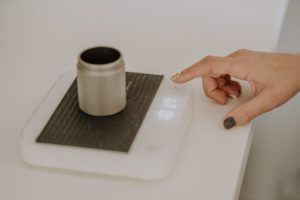
Discover the Best Manual Coffee Grinders
If you are looking for the best manual coffee grinder to brew a delicious cup of coffee at home, sit back, relax, and simply scroll down. I’ve embraced my inner coffee geek and reviewed the best hand coffee grinders ranging from entry-level to high-end so you can easily find the grinder that is right for you. All recommendations were rigorously tested at home and at World of Coffee events. I personally talked to some of the founders, like Christian Biernatek of KINU and Raphael Braune of Comandante, to learn more about what makes their products so great. Starting off strong with my top picks, this article also features the best budget friendly hand held coffee grinders.
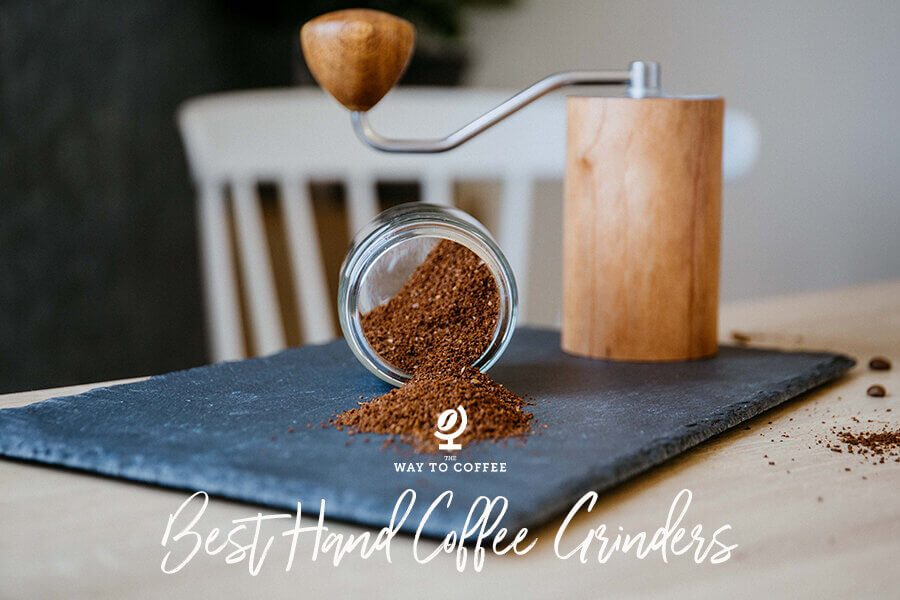
This article contains affiliate links to Amazon. As an Amazon Associate I earn from qualifying purchases.
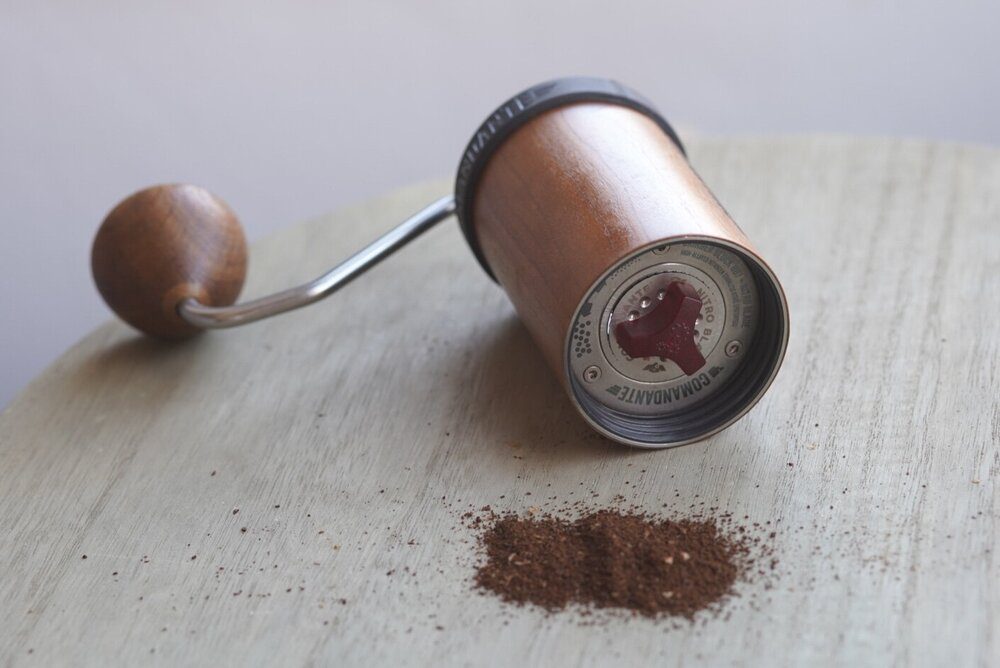
Overall Best
Comandante C40 MK4
- Super consistent grind distribution.
- Premium “buy it for life” build & burr steel quality.
- Versatile across espresso and filter methods.
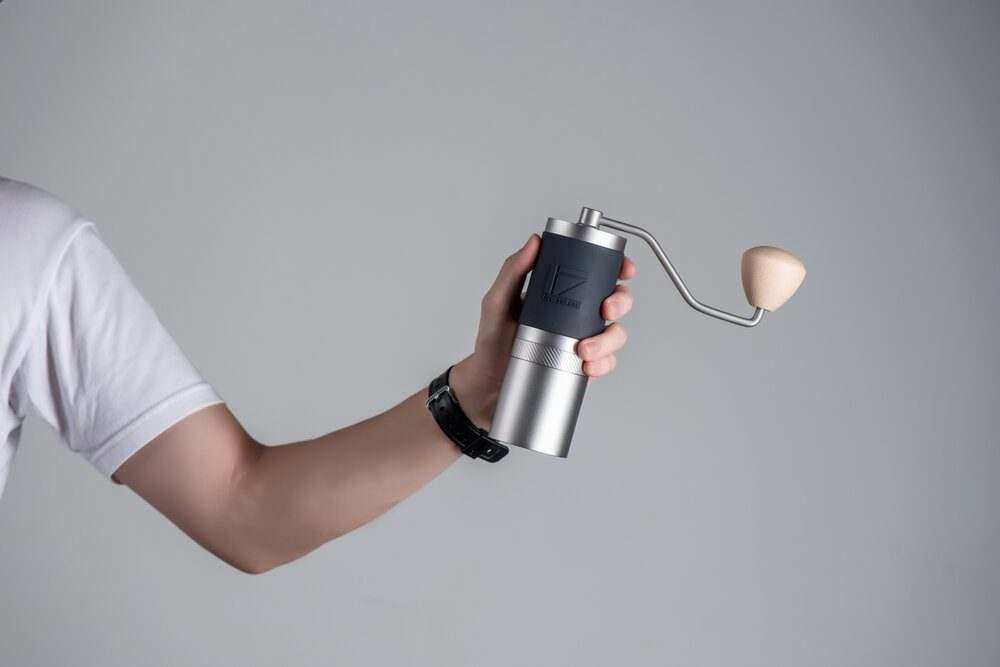
Runner-Up
1Zpresso J
- Solid build.
- Grinds fine enough for espresso at a lower price point.
- Best all-rounder for home baristas.
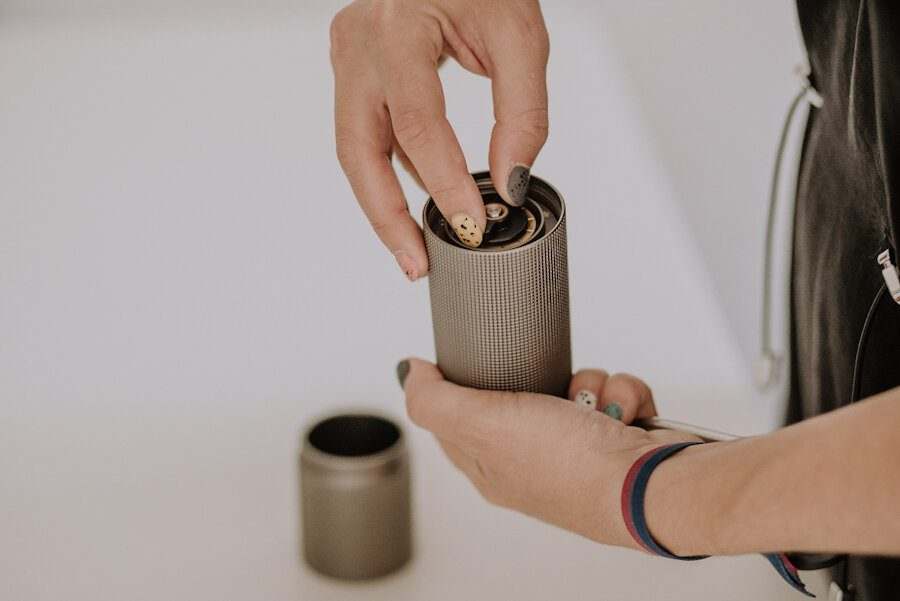
What Kind of Manual Coffee Grinder is Best?
What kind of manual grinder is best for your depends on the purpose for which it will be used. For espresso drinkers, the grinder must be precise, especially in the very fine to medium-fine range. Even the smallest adjustments should be possible, so paying attention to the number of microns each adjustment steps adds is important. Filter coffee drinkers, on the other hand, are not interested in fineness, but rather whether the grinder still delivers consistently even results in the medium-coarse range. Check this table for a quick comparison of all featured grinders.
| Grinder | Burr Ø / Type | Adjustment | Capacity | Weight | Best for | Quick note & CTA |
|---|---|---|---|---|---|---|
| TIMEMORE Chestnut C2 | 38 mm CNC stainless conical 1.50 in | Stepped ~36 internal steps | 25 g 0.88 oz | 470 g 1.03 lb | Budget / travel / pour-over | Solid value, lightweight and quick for its class. Check price |
| Comandante C40 MK4 | Nitro Blade steel conical 1.54 in | Stepped; high-consistency geometry | 40 g 1.41 oz | 740 g 1.63 lb | Pour-over / filter clarity | Benchmark burr geometry for clarity. Check price |
| 1Zpresso J | 48 mm conical stainless steel burrs 1.89 in | Internal stepped ~30 clicks/rotation | 30–35 g 1.06–1.23 oz | 705 g 1.55 lb | Fast all-rounder | Speed + consistency for the money. Check price |
| Kinu M47 Simplicity | 47 mm conical stainless steel burrs 1.85 in | Micro adjustment (manufacturer: down to ~5 µm) | 40 g 1.41 oz | 1050 g 2.32 lb | Espresso / precision dialing | A heavy-duty, repeatable espresso workhorse. Check price |
| KINGrinder K6 | 48 mm stainless heptagonal burrs 1.89 in | External collar — 60 clicks/rotation (≈16 µm / click) | 25–30 g 0.88–1.06 oz | 630 g 1.39 lb | Espresso-capable / all-rounder | Best-value, good espresso potential for the price. Check price |
| Porlex Mini | Ceramic conical burr 1.85 in | Stepped — larger per-click jumps | 20 g 0.71 oz | 250 g 0.55 lb | Ultra-portable | Tiny and robust, perfect travel option. Check price |
| Hario Skerton Pro | Ceramic conical burr ~1.54 in | Click adjustment | 100 g 3.53 oz | 544 g 1.20 lb | Large-batch / budget home brewing | Big hopper for batch grinding; okay value. Check price |
My Favorite Manual Coffee Grinders
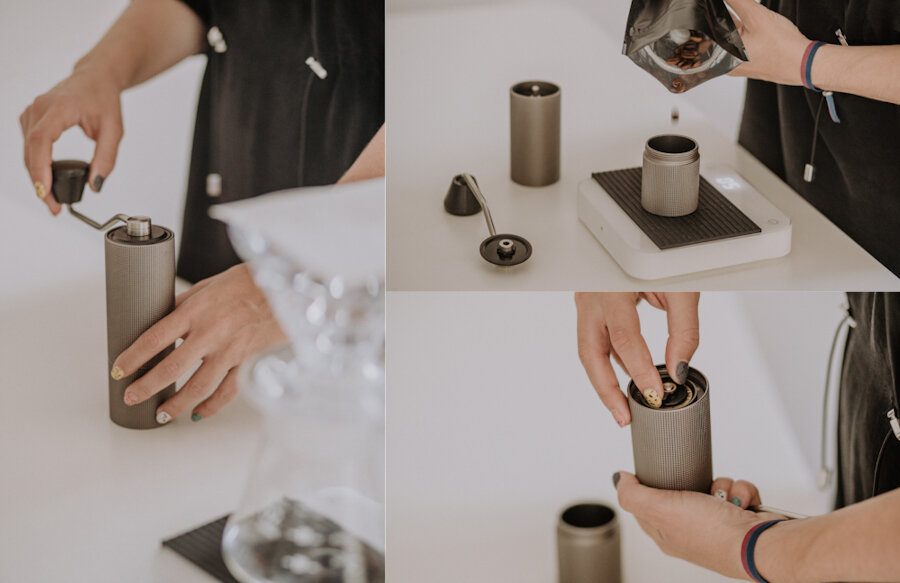
- Grinds quickly with a good range of adjustments for different brew methods.
- Nicely designed, solid, and sturdy.
- Good value for money.
- Some parts are made of plastic, although the adjustment knob has been updated to metal.
- Fine grinds for espresso show inconsistencies, steps are too big to fine tune espresso grind.
In my opinion the Timemore C2 is one of the best budget hand grinders out there. It comes with a decent set of 38 mm stainless steel conical burrs and provides a consistent grind for an affordable price. Turning the crank is a smooth and fast affair for medium grinds.
Capacity
The hopper capacity of this handheld coffee grinder is approximately 25 grams, depending on the size of the beans. The dimensions of the body are 147×52 mm and the handle is 159 mm long. In total the grinder puts just around 435 g on the scale.
Materials
The Timemore Chestnut C2 comprises a combination of aluminum, stainless steel and plastic parts. To describe this manual burr grinder from head to toe, both the ground catcher and the upper body are made of a mixture of aluminum and plastic, providing good grip and overall aesthetics. The handle is made of aluminum as well as plastic and has good ergonomics.
Grind Settings
To adjust the grind setting Timemore supplies users with a dial and click mechanism that can be operated when removing the bottom catcher. Even though the manufacturer suggests 6-12 clicks for espresso, this is not the grind adjustment where the C2 shines. Once you hit the 15-24 click range for Pour Over or 25-27 clicks for French Press you’ll be rewarded with a smooth and speedy grinding experience and satisfactory particle distribution. While this hand crank coffee grinder does produce a noticeable amount of fines when comparing it to high end models, it is performing great considering its affordability.
My Conclusion
The Timemore C2 hand grinder is great value for money and unbeatable in its price range. Despite having some plastic parts, it feels robust and sturdy. I find the design to be aesthetically pleasing and, as someone with smaller hands, really appreciate the non-slip grid pattern of the housing. For espresso, the steps are too big to fine tune a grind and I found inconsistencies in the grounds at finer settings. To sum it up, if you are just embarking on your home barista journey, you can’t go wrong with this entry-level manual grinder.

- High-quality steel burrs that produce consistent and uniform grinds
- Wide range of adjustments from very fine for espresso to coarse for cold brew.
- Durable and very good grind consistency.
- Expensive compared to other manual grinders on the market.
I’ve recently traded my first ever manual coffee grinder, the Porlex Mini, for a Comandante C40 Nitro Blade to step up my home barista game. While the price for this beautifully designed coffee grinder is definitely premium, it’s the ultimate choice both for home brewers and professionals. Comandante grinders are built to last, well-engineered with attention to detail, and famous for an incredibly even grind from ultra-fine to coarse.
Capacity
The hopper and glass jar at the bottom both comfortably hold 40 grams of coffee.
Materials
The high quality parts of the Comandante handheld coffee grinder are mostly made of stainless steel, apart from the finish layer that is laminated on top of the body, the wooden knob on the handle, and the glass jar that catches the grinds. It features a couple of 100% food save plastic parts too, such as the lid. When grinding, the grip is good, but having small hands means I struggled a little with the smooth surface. Since using the custom made Comandante rubber band my grind experience really improved.
The glass jar fits perfectly on the top of the grinder so that no beans can bounce out when filling the hopper. It did happen to me that the glass jar dropped while I was grinding and shattered into a thousand little pieces, so be extra careful that you screw it on tightly before grinding your beans. The backup jar included comes in handy at this point.
The real stars of the show are the stainless steel conical burrs that produce an outstanding particle distribution. Comandante doesn’t talk about the outer burr size, as it gives no information related to the performance. Their burrs are engineered to deliver the perfect mix of grind performance, speed, efficiency and ease of grinding.
Grind Settings
To adjust the grind size, the extensive clicking mechanism allows you to brew anything from espresso to french press, all the way to cupping bowls. You are likely to adjust your grind size by setting the 3-pointed dial somewhere between 5 and 35 clicks, but the number of available clicks extends well beyond that. There is a helpful illustration at the bottom where the click mechanism sits to show you what direction to move towards depending on whether you’re after a finer or coarser grind.
To fine-tune your grind further, Comandante developed the Red Clix axle, which doubles the number of settings. Every click on the standard axle increases your particle size by 30 microns, whereas the Red Clix axle offers steps of 15 microns.
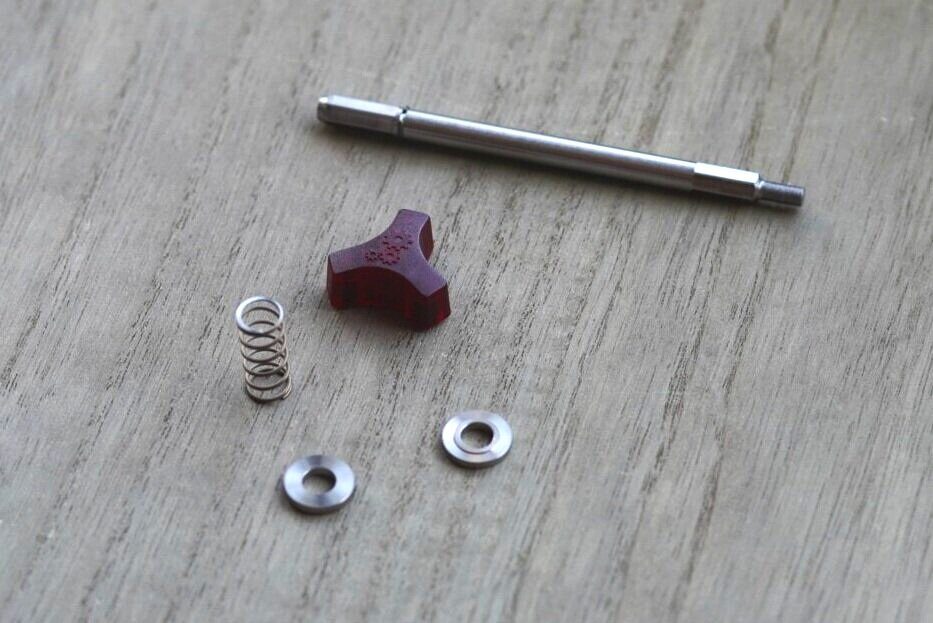
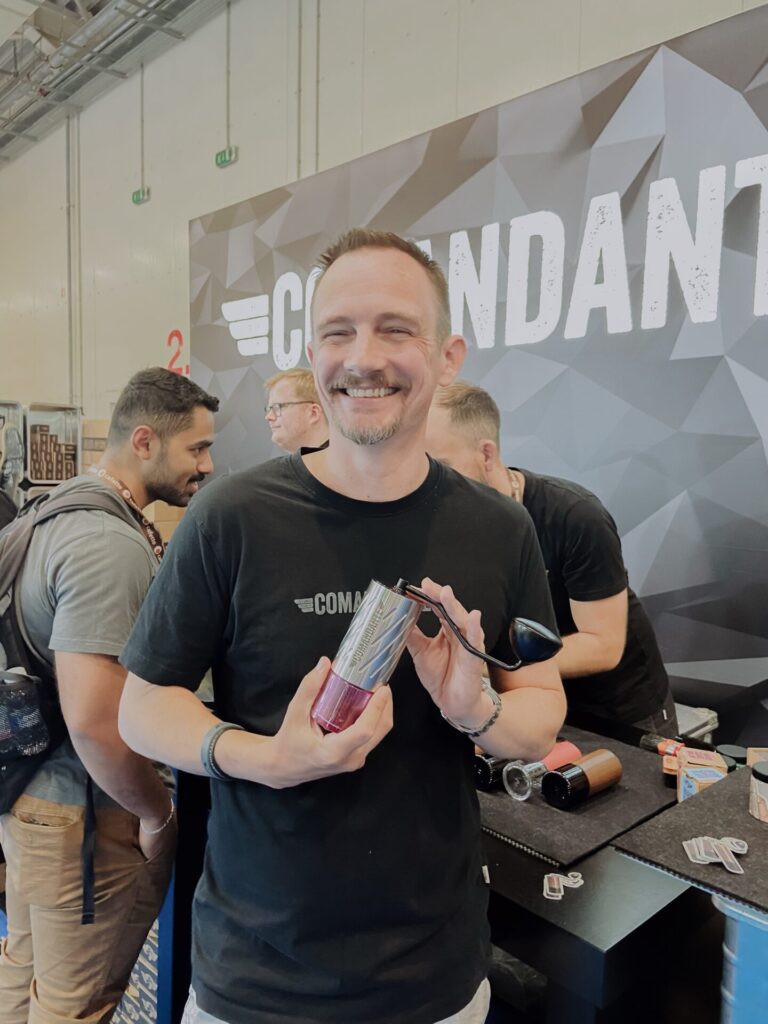
My conclusion
The Comandante C4 Nitro Blade excels most of the manual grinders in this line-up, both price-wise and performance-wise, and meets the requirements to extract all the right flavors of high-quality specialty coffee. If you’re already familiar with the world of specialty coffee and want to take your brews to the next level, then this is the grinder for you! It is suitable for both hobby and professional use and will last you a lifetime if well taken care of. You can find more information on the Comandante website.
1Zpresso J – Best Cost-Effective Hand Grinder

- Premium build quality and a nice clicky feedback when adjusting the grind setting.
- Larger burrs (48mm) than some of its competitors and grinds faster.
- Consistent grind.
- Hopper size limited to 35 grams. Not suitable for larger batches of coffee.
If you’re looking for a fast, solid hand crank that doesn’t break the bank, the 1Zpresso J (the current retail name, previously JX) is still the one to watch. It keeps the big, sharp 48 mm conical burrs that make it faster than many other manual grinders and give you very consistent results for filter and light-to-medium roast work. It’s slimmer than a Comandante, so it’s easier to carry and feels better in the hand for longer sessions, and the rubber grip and included cleaning brush make maintenance easy.
Capacity
The hopper up top will hold a solid 30-35 grams of beans.
Materials
The majority of parts are made from stainless steel, including the conical burrs. When holding it, the 1Zpresso J feels sturdy and durable. A rubber sleeve ensures a good grip while grinding. The best way to clean it is with a cleaning brush, which is luckily included. All parts are quickly disassembled if you need to do a thorough cleaning.
Grind settings
The 1Zpresso J Manual Coffee Grinder covers a wide range of grind settings. It is easy to dial in and offers a great spectrum of adjustment levels to find the sweet spot for your coffee. It can work for espresso but isn’t ideal. It comes with a 30-click system and roughly 25 microns per click, which is great for pour-over and most brew styles but not the ultra-fine stepping that espresso purists want.
My conclusion
The 1Zpresso J is a high-end, well-engineered hand coffee grinder perfect for pour-over. Grinding with it is a breeze and the grind consistency is remarkable for its price range. A solid choice for true filter lovers!
When Kinu presented the M47 Simplicity at the World of Coffee in Athens, I had the chance to talk to the founder Christian Biernatek, who launched Kinu with his father in 2016. Christians has an engineering background, which is immediately visible in the products he develops. The Kinu M47 Simplicity is more affordable than the Classic due to some tweaks in the design but brings the same grind quality as its parent grinder. I got to experience the M47 Simplicty first hand and some of its highlights include an outer adjustment wheel, a twist and open magnetic grind catcher and an extremely smooth grind experience.

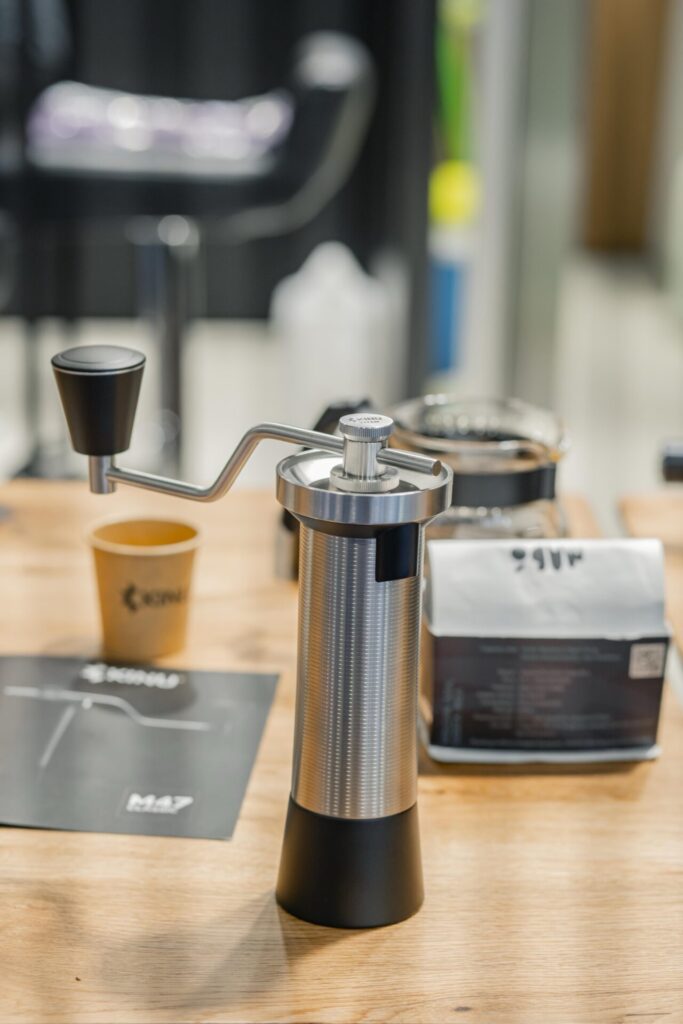
- Stepless, micron-level adjustment that allows micro-adjustments as fine as 5 microns, with a clearly marked zero point for easy recalibration.
- 47 mm conical steel burrs, auto-centering via Morse-cone principle with minimal retention by design.
- Robust build with stainless steel body, four ball bearings and magnetic catch cup.
- Still heavy compared to basic hand grinders, though lighter than the Classic.
Capacity
Holds around 40 g of ground coffee, enough for a V60 or several espresso shots at once.
Materials
The M47 Classic model has a stainless-steel body internals, four steel ball bearings, and a magnetic steel catch cup. The Simplicity variant is also made from stainless steel, but Kinu trims some of the bulk by using lightweight ABS for the thumb stop, funnel, and catch cup to cut weight. The alignment is still excellent thanks to the same burr mount. Inside, the burrs are auto-centered using a Morse-cone system and supported by four ball bearings, so the grind feels smooth and consistent every time. The catch cup itself snaps on magnetically with eleven tiny magnets which is oddly satisfying.
Grind Setting
Where the M47 Simplicity really shines is in grind control. The stepless adjustment dial moves in tiny increments, down to 5 microns, so you can dial in with surgical precision whether you’re pulling Turkish coffee, espresso, a pour over, or even a larger batch brew. Thanks to the zero-point reference, it’s quick to reset and move between grind settings without guesswork. Expect roughly 30 to 40 seconds to grind 18 g for espresso. Coarser settings are quicker.
My conclusion
If you’re in the market for espresso grade coffee grinds and want bulletproof repeatability, then the Kinu M47 Simplicity is perfect for you. It’s slightly heavy and not cheap, but it’s one of the few hand grinders that genuinely replaces an entry-level electric grinder for shot work. If you’re filter-only and are chasing ultra-clean cups, you’ll get more pop from a more filter-focused burr set.
- External collar with 16 µm per click and 60 clicks per rotation makes for repeatable dialing across methods.
- 48 mm stainless steel burrs, solid speed for the price class.
- Minor fit/finish quirks.
- The click-math can be confusing on day one.
For a budget grinder, the KINGrinder K6 feels reassuringly solid. The external collar makes jumping from espresso to V60 easy, and 16 µm steps give you real granularity at espresso—something many cheap stepped grinders lack.. Let’s take a look at the grinder in more detail.
Capacity
The bean receiver holds roughly 30–35 g of whole beans, depending on their size.
Materials
The K6’s shell is machined aluminium; the burrs are stainless steel, and the grinder uses dual-bearing support around the shaft to keep the burrs aligned under load. Expect a firm textured grip on the body and good overall rigidity for day-to-day use. Something to note here: the crank can be a loose fit for some batches, the grinder is top-heavy and can tip if you don’t stabilize it.
Grind settings
The K6’s external collar lets you visually and physically click through grind sizes: 60 clicks per revolution at 16 µm per click. Practically, that gives you repeatable, tactile steps you can return to. For espresso a good starting point is in the mid-30s to upper-30s on the dial and moving from there depending on roast and dose. For pour over, you’ll likely set somewhere between 60 to 120 clicks, you’ll still need to taste and tweak, but the dial makes those tweaks reliable. Because you’re running 48 mm burrs, the K6 grinds surprisingly fast for a hand grinder. What’s cool is that the K6 is also drill-compatible thanks to a 6.35 mm (¼-inch) hex shank on the crank, so if you want to speed things up even more you can hook it to a low-speed driver.
My conclusion
For filter and Aeropress the KINGrinder K6 consistently delivers good, even particle distributions for its price class; for espresso it’s impressive for a hand grinder. You can pull shots that taste clean and consistent, but it’s not as buttery or silky at the very finest settings as premium manual grinders, like Kinu or Comandante territory. If you grind a lot of very fine espresso every day, there are smoother-feeling premium options, but for switchers (espresso one day, V60 the next) the K6 is one of the best compromise grinders out there. While it’s not flawless, buy the K6 if you want a solid manual grinder that will do both espresso and pour-over well, move between methods without a headache, and cost you a fraction of the big-name premium choices.
On a Budget? Popular Entry-Level Hand Grinders That Won’t Break The Bank
Porlex Mini – The Perfect Travel Companion
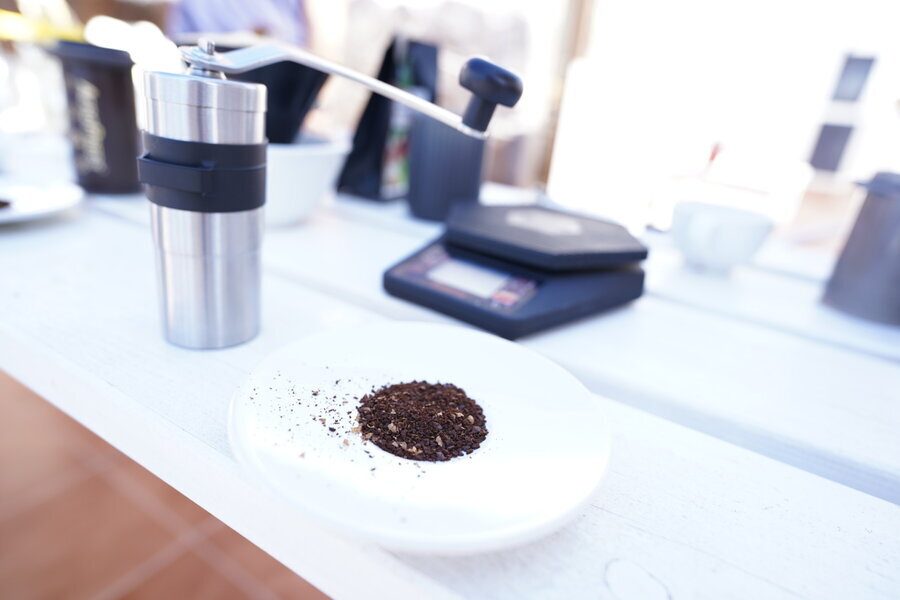
- Affordable.
- Compact and portable thanks to detachable handle. Fits inside an AeroPress.
- Durable ceramic burrs.
- Struggles with grind consistency for coarser grinds.
Capacity
The hopper capacity is quite limited with maximum 25 grams of coffee. If you regularly brew larger batches of filter coffee, this is not the grinder for you. But if you’re a lone wolf like me that is brewing one cup of coffee at a time then it’ll do just fine. Depending on your recipe you’ll get enough coffee grounds for 1-2 cups out of a single run.
Materials
The housing of the Porlex Mini is made from stainless steel and comes with a lid. A smart little detail I really like is the rubber ring around the body that not only makes for a better grip but also allows you to attach the handle to the side of the grinder when you store it away. Its spring-loaded ceramic conical burr set is made from Japanese clay and can easily be cleaned using a soft brush. Overall this hand crank coffee grinder feels long-lasting and its compact size makes for an easy-going and speedy grinding experience.
Grind Settings
By removing the grind catcher you’ll be able to adjust your grind setting with a number of clicks on the three-legged star at the bottom of the body from anywhere between fine and french press coarse.
My conclusion
The Porlex Mini is a durable coffee hand grinder and a budget-friendly choice for aspiring home baristas. It’s particularly handy for traveling as well as outdoor brewing as it is nicely portable. It even fits into the body of the AeroPress.
The grind adjustment wheel makes finding your favorite setting easy. That being said, you’ll likely encounter some grind inconsistencies the coarser your grind setting, which is a normal occurrence with entry level grinders. If grind uniformity in medium to coarse grinds is something you value most in a grinder, take a closer look at the next high-end options.
Hario Skerton Pro
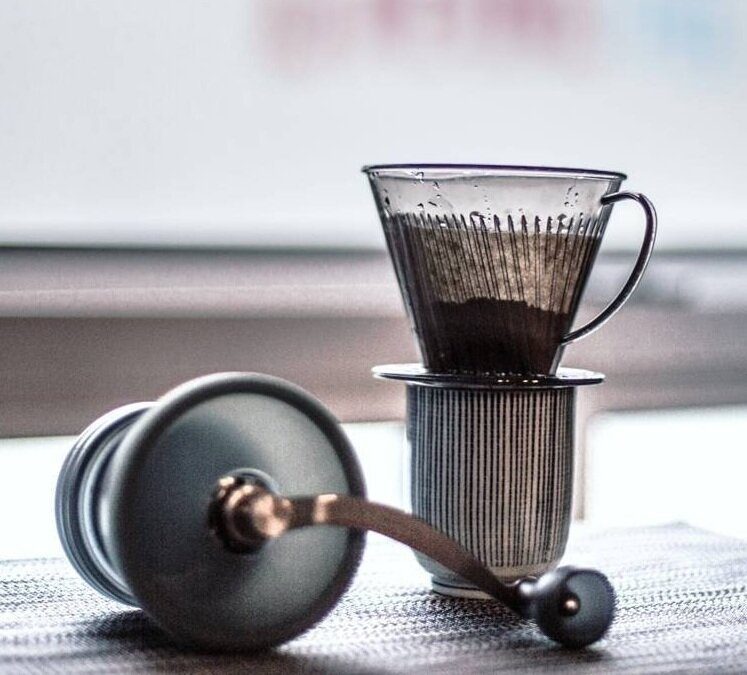
- Large capacity hopper and grind catcher.
- Affordable and easy to use.
- Slow and tiring to grind with.
- Lack of grind consistency.
- Bulky to hold in hand while grinding
This Hario Skerton Pro is an improved version of its predecessor Skerton, which looks exactly the same. It’s a handy coffee grinder that will last you a long time if you take good care of it. It is equipped with a burr stabilizing plate that helps keep the center shaft in place for a more consistent grind. I recommend it for its affordability, volume, and easy usability in day to day life. Considering the low price point the lack of consistency when grinding coarsely is somewhat acceptable.
Capacity
If you brew in batches then the volume of this hand grinder will satisfy your needs. The hopper up top will hold about 75 grams of beans and the glass jar at the bottom will hold up to 100 grams of ground coffee.
Materials
All of the metal used to build this grinder is stainless steel. The burrs are made from ceramic, this way they won’t rust as can happen with metal burrs. They also don’t affect the taste of your coffee. The bottom part is made out of glass and comes with a silicone pad that will protect the glass from breaking, but also your wooden table or counter from scratches.
The top is covered with a soft lid to keep the beans from popping out. After grinding, you can save the ground coffee in the glass if needed as it comes with a lid as well. All parts are easy to disassemble and completely washable. For cleaning the burrs a toothbrush will do the trick.
Grind settings
The Hario Skerton Pro allows you to adjust your grind settings with a locking piece and a little thumbscrew under the handle that enables you to regulate the distance between the burrs. It’s a trial and error activity. I prefer a click system as it is more precise and enables you to recreate a previous grind setting more easily.
The consistency is really quite good for finer grinds but gets less reliable the coarser the grind. If you are planning to use it for a coarser grind setting needed for brewers like the Chemex, you might want to take a look at the Skerton Pro which achieves better results with coarser grind sizes.
My conclusion
The Hario Skelton Pro is a reliable hand coffee grinder for a low price. It’s nicely designed, not too heavy, and comes with ceramic burrs. The drawbacks of this hand held coffee grinder are a lack of consistency with coarser grinds and the difficulty to recreate grind sizes as there is no clicking mechanism in place to help you remember previous settings. Having small hands I also found the ergonomics to be somewhat lacking.
Why is Using a Quality Hand Coffee Grinder so Important?
One of the golden rules when tipping your toes into the world of specialty coffee is to freshly grind your coffee beans with a quality hand crank grinder just before brewing.
Coffee is a delicate product that needs to be handled with care in order to preserve its flavors and aroma. Pre-ground coffee has already lost many of its aromatic qualities by the time you buy it and continues to do so while sitting on your shelves. Whole beans, if stored in an airtight container and ideally consumed between 5-7 days and 4 weeks after the roasting date, keep all that deliciousness locked inside that would otherwise escape before the coffee has a chance to land in your cup.
For an even extraction, coffee grounds need to be evenly sized and shaped. A quality coffee hand grinder will produce the precise and consistent grind you need to brew a tasty cup of coffee at home.
How to Choose the Right Manual Coffee Grinder?
When choosing what manual burr grinder to buy, the key features to consider are the quality of the burrs for grind consistency, the grind settings as well as its capacity and portability. Depending on your budget, there are excellent options available on the market from entry-level to high-end and premium.
Materials and Handling
The body and base of most hand coffee grinders are made of stainless steel, plastic, glass, wood, or a combination of these. Pay attention to the length and shape of the handle as this impacts how portable the grinder is. While it is important for the grind experience and overall feel of the grinder to consider what material the body and handle are made off, you want to pay extra attention to the material used for the burrs. You have the option between ceramic and steel burr sets, the latter being the sharper and more efficient choice, whereas ceramic burrs tend to produce a lot of dust.
While producers often emphasize the burr size, this refers to the outer ring diameter, which can be misleading, depending on how big the distance is from the outer ring to the cutting edges. The measurement of the cone diameter delivers a fairer comparison of the actual burr specifications. Hence, burr size will not be a decisive factor in this article. Opting for a well-engineered hand crank coffee grinder that comes with quality burrs will significantly improve the taste of your coffee.
Capacity
Each hand held coffee grinder has a different hopper and basket capacity, which is important to consider when you want to brew larger quantities of filter coffee at once. If you end up grinding in batches because your hopper is too small, the first round of coffee grounds waiting in your brewing device will start losing flavor while you’re grinding the remaining coffee, which is not desirable.
Grind Settings
To customize your brew, adjusting the grind size to the brewing device is crucial. Will you be brewing coffee with a french press? Will you need to produce a fine grind suitable for turkish coffee or espresso? To brew coffee with a variety of different coffee makers, you need a handheld coffee grinder that caters to your needs. Keep in mind that hand grinding your beans for espresso is a lengthier job as fine grinds require more effort and take longer to produce than coarser filter grinds. In this case, a bigger set of burrs will get the job done faster.
Particle Distribution and Grind Efficiency
To help you compare the most popular hand grinders, I looked at two key factors that are most relevant to home baristas:
Particle distribution: how uniform the grind size is, and how many fines and boulders are produced
grind time: how long it took me to grind 20g of coffee at a medium setting suitable for pour-over (now keep in mind, while I am well trained in hand grinding coffee, I am a coffee nerd, not a weight lifter :))
The results below are based on my personal findings.
| Grinder | Particle Distribution | Time to Medium Grind 20 g |
|---|---|---|
| Comandante C40 MK4 | Extremely consistent, unimodal grind with very few fines. | 40 s |
| 1Zpresso J | Clean distribution; slightly more boulders than Comandante. | 30 s |
| Timemore Chestnut C2 | Noticeable fines, but solid for an entry-level grinder. | 30 s |
| Kinu M47 Simplicity | Precise alignment; low variance but more fines at coarser settings. | 45 s |
| KINGrinder K6 | Solid uniformity for its price range. | 30 s |
| Porlex Mini | High fines; older ceramic burr design. | 47 s |
| Hario Skerton Pro | Inconsistent with many fines, though improved over original Skerton. | 75 s |
Frequently Asked Questions about Manual Coffee Grinders
Are Manual Coffee Grinders Better than Electric Grinders?
For home brewers who really want to get hands-on with their morning brew, manual coffee grinders are the way to go. Not only are they more affordable than electric grinders, they’re also more portable. This makes them the ideal option for people who are always on-the-go. The best part? If you choose the right model, the taste of your coffee comes down to your own effort and know-how. This creates an immersive and rewarding coffee-making experience, as you can experiment with different grind settings to achieve the perfect grind size for your brewing method.
However, it’s important to note that the finer the grind, the more time-consuming and challenging the grinding process can become with a hand grinder. This is particularly true for espresso enthusiasts who require very fine grinds for their shots. Grinding each dose by manually can become a tiresome process, so it’s worth considering an electric grinder if you’re looking for a faster and more convenient option.
That being said, if you’re looking for an electric coffee grinder that doesn’t break the bank, the Timemore Grinder Go is a great option to consider. It’s compact, portable, and has a range of settings that allow you to achieve the perfect grind for your desired brewing method.
In conclusion, while electric grinders may be a popular choice, manual coffee grinders offer a unique and rewarding coffee-making experience that’s worth considering. If you’re interested in learning more about the pros and cons of manual versus electric coffee grinders, be sure to check out our in-depth article on the topic.
How do I clean and maintain a manual coffee grinder?
Disassemble: Carefully take apart your grinder, following the manufacturer’s instructions. This usually involves removing the handle, the top nut, and the grind adjustment piece to access the burrs.
Clean the Burrs: Use a small brush (a soft toothbrush can do the trick) to gently clean the burrs. Brush away any residual coffee grounds, making sure to reach into all the nooks and crannies.
Clean the Grinder Body: Use a slightly damp or dry cloth to wipe the inside and outside of the grinder body. Avoid using water directly on the grinder to prevent damage to the metal parts.
Reassemble: Once all parts are clean and dry, reassemble your grinder.
Regular Maintenance: Repeat this process every few weeks, or more frequently if you’re grinding dark roast beans, which tend to be oilier and can leave residue more quickly.
How do I prevent static and mess when grinding manually?
Keeping the process of grinding coffee clean and static-free is a common concern among coffee lovers, especially when using manual grinders. Here’s how you can manage it:
Water Droplet Technique: Also known as the Ross Droplet Technique, this method involves adding a few drops of water to your coffee beans before grinding. The water helps to reduce static electricity that causes coffee grounds to stick to the grinder. Using a fine mist spray bottle is ideal.
Wait Before Opening: After grinding, give the coffee a moment to rest before opening the grinder. This allows any static charge that may have built up during grinding to dissipate.
Grind Slower: Grinding at a slower pace can also help minimize static. The friction from fast grinding can contribute to a static charge.
Choose the Right Grinder: Some grinders are more prone to static than others. If it’s a constant issue, you might want to consider getting a grinder with anti-static materials.
Regular Cleaning: Keeping your grinder clean can also help to reduce static. Coffee oils can build up over time and contribute to static build-up.
What are the pros and cons of ceramic vs steel burrs in manual grinders?
Ceramic burrs maintain their sharpness for an extended period, ensuring a consistent grind size. Unlike metal, ceramic does not conduct heat easily, meaning it won’t cause your coffee beans to overheat during the grinding process, which could negatively impact flavor. However, ceramic burrs are more fragile and can chip or crack ore easily than burrs made of steel.
Steel burrs are robust and less likely to chip, lending them a degree of durability that ceramic burrs lack. Steel burrs often grind beans quicker than ceramic due to their sharpness and strength. While they offer certain advantages, steel burrs can be more expensive than ceramic ones and may dull more quickly over time, affecting the consistency of the grind.
